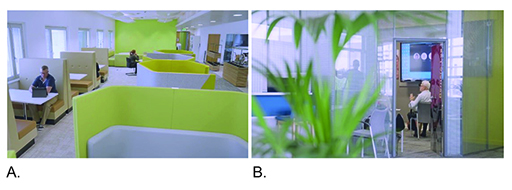8.1 How to have good hybrid meetings
In the following sections we explore how to improve meetings and team collaboration in a hybrid workplace.
In the video below, How to have a hybrid meeting that works for everyone (Harvard Business Review, 2021), social psychologist Heidi Grant shares best practices for hybrid meetings.
Transcript: You are viewing this video in Youtube: The Open University is not responsible for external site content
Good hybrid meetings require a clear purpose and technology that works.
Technology
Your organisation will have preferred technology in terms of hardware and software. The most popular video conference platforms (VCPs) are Zoom, Microsoft Teams, Google Chat, Webex by Cisco and Adobe Connect. It is also useful to consider mobile apps such as WhatsApp and Facetime: I use these informal tools when I am away from my normal location and need a ‘quick call’ or if I’m working with people whose mobile technology is more stable than online tools.
Onsite meeting areas
Even before the pandemic, how we managed hybrid meetings was evolving; they often didn’t take place in formal meeting rooms. Participants who had virtual conferencing platforms on their laptops or mobile app technology were often having hybrid meetings wherever was convenient.
For example, I used to travel to India, where my previous team was based. If our connecting flight was delayed, my colleague and I used to sit in airport lounges, with a laptop, and meet online with the team based in the office so we could rearrange schedules.
As organisations redesign how buildings are used and the technology they either already have or plan to invest in, they are thinking differently about what a meeting space needs to be.
In the Hybrid working: organisational development [Tip: hold Ctrl and click a link to open it in a new tab. (Hide tip)] course, you can explore how The Open University has created show homes. These are areas within the campus that have been repurposed and designed to provide workspaces and meeting rooms,and access to technology to allow for onsite, hybrid and remote meetings.
Formal meeting rooms
Most organisations are likely now to be investing in and designing meeting spaces for the future, but the reality is not all will be able to implement purpose-built meetings rooms, such as those designed by Microsoft, who have done extensive research and have design teams exploring ‘Designing the new hybrid meeting experience—for everyone’ (Microsoft, n.d.).
How you use formal meeting room spaces will depend on the technology available and design of the room. While you may have technical equipment provided, many people now will also expect to be able to use their own laptop or tablet, and it can often be easier to have everyone join the meeting through their devices, as well as using the main shared screen, especially if you are using a ‘single’ external camera device.
If you are the meeting organiser, ensure that you understand how the room was designed to be used and how to use the technology within it. If you require training, arrange this in advance to avoid things going wrong during your meeting, which can happen.
Positioning of cameras is really important. Where possible, you should aim for all attendees’ cameras to be at eyeline, as this helps support non-verbal communication and ‘cues’.
While investing time to prepare will help your meetings run efficiently, if you frequently attend hybrid meetings, you and those who attend will eventually find that you will naturally adapt to the spaces and technology, and so time needed for preparation will gradually reduce.

